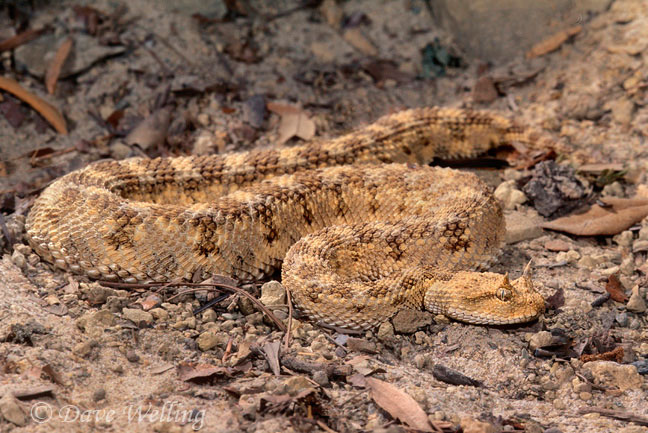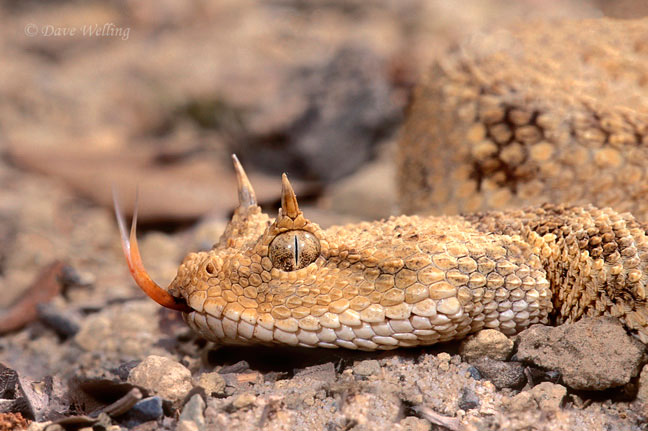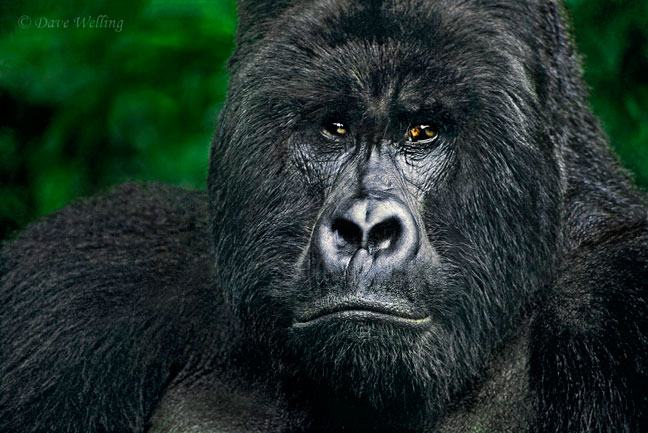Portrait photography is not just about people, it can apply to wildlife subjects as well. Proper technique and subject knowledge is equally important in capturing great images of wild animals. First and foremost, know your subject: its behavior, fright/flight distance, how dangerous it is and when to back off if you are disturbing the animal in any way. Look for special behaviors or expressions that make the difference between a snapshot and a great image.
For example, this image below of the horned desert viper is a nice “record” shot of a captive specimen, showing the scale pattern and something of its probable habitat.
Now compare that to this close-up portrait below. It exhibits the snake’s unique horns, detail of the elliptical pupil, and captures a tongue flick as it senses its environment. This puts the viewer on a much more intimate level. When you photograph wild animals try and get down to eye level with your subject, whether you are capturing portraits, behavior or in-environment images. The resultant image will have considerably more impact.
I noted the significance of the eye earlier, as this is the most critical element of your wildlife portrait (unless you are doing some very special lighting, black and white graphic or artistic blurring). Make sure you have the eye in sharp apparent focus and try and orient your camera (or use slight fill flash) to brighten or add catch-light to the eyes. Many wild animals have heavy brows or very dark eyes and, without catch-light, they appear dull and almost dead.
This silverback mountain gorilla (a highly endangered species) photographed in his cloud forest home in Zaire is a perfect example. Gorillas have a very prominent, heavy brow which helps shade their eyes. Unfortunately, without some element of flash, the eyes will always appear as dark sockets with no life. I used a slight amount of fill-flash with Rugabo (his official name) to give life to the image (sadly, Rugabo was killed by poachers about a month after I photographed him).
If you have the opportunity, spend some time with your subject. Study your animal and learn some of its behavioral characteristics. Then, incorporate them into your images to add to the overall impact of your photo.
I spent a significant amount of time with a pair of baby Bengal tigers at a wildlife rescue facility near my home and got to know the pair quite well. The young lady shown here would often play with sticks and feathers she would find in her compound. While doing so, she would give me a coy look almost daring me to take away her toy (I never even considered it!). Her staring at me adds to the overall image. Be creative with your portrait work – the images do not have to be the static high school yearbook look. They can be so much more if you take the time.

About the author: Dave Welling is a full time professional photographer specializing in wildlife, landscape and nature with over 75,000 6×7, 6×4.5, and 35mm film and digital images. He has been capturing evocative images of the natural world for over 25 years, producing the highest quality images for publication. His images often capture unique behavioral characteristics of wildlife or special lighting or weather conditions of landscapes. You can see more of his work at www.strikingnatureimagesbydavewelling.com.
Have something to add to the story? Leave a comment or email editor@outdoorphotographyguide.com.



I've always been drawn to photographing wildlife of any type, but I enjoy taking photos of the more exotic animals like the the baby Bengal tiger and the primates. The only "wildlife" animals that I've been able to photograph so far, are the ones that are in "zoo" type facilities. I'm definitely going to be visiting the website for Dave Welling. He takes the kind of photos that I would love to aspire to. So sad to read that the Silverback Gorilla - Rugabo - pictured above was killed by poachers! Poaching really needs to be stopped, but it's so hard to catch the people that are doing this heinous activity. :(
Love this! The photos are amazing! So sad what happened to Rugabo. Such a beautiful creature. :(
Very good lesson with beautiful examples.
Everyone loves what you guys are up too. This kind of clever work and coverage! Keep up the terrific works guys I've incorporated you guys to my blogroll.